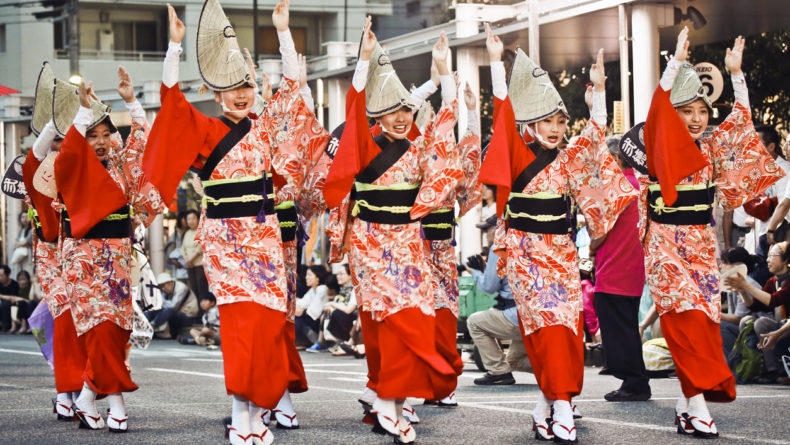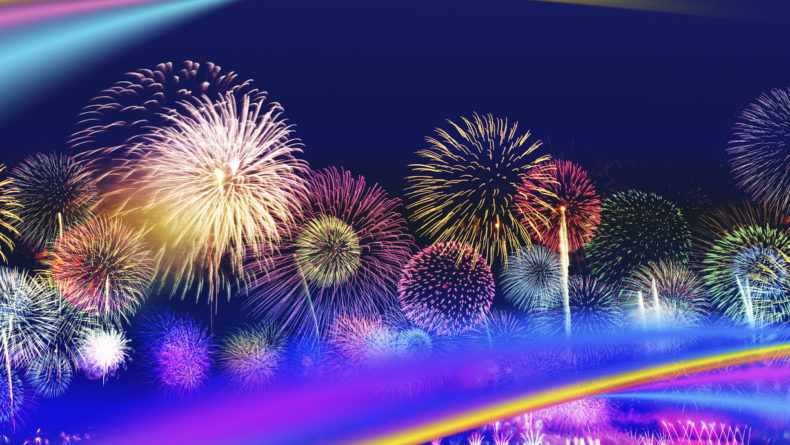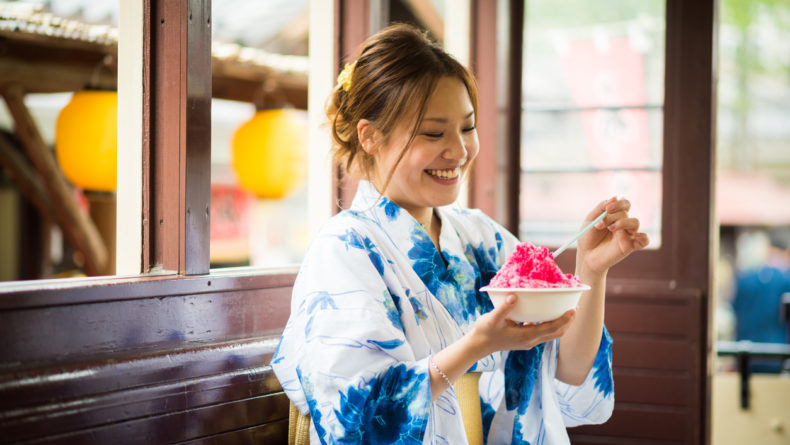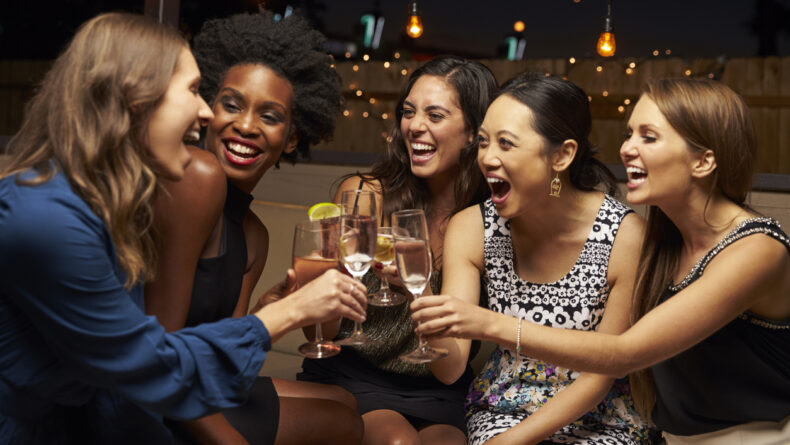2019 Fireworks Festivals Across Japan
Magnificent fireworks light up the sky across Japan—from Hokkaido to Tokyo to Kyushu!
Summer in Japan means it’s hanabi (fireworks) season! Throw on your yukata, pack a picnic mat, and get ready to brave the crowds to see some of the most impressive fireworks across the country.
Fireworks festivals are a staple for Japanese summers, drawing in hundreds of thousands of people from across the country. But these aren’t your 15-minute, Independence Day or New Years fireworks shows.
Japanese fireworks shows often last for over an hour, and feature more than 10,000 fireworks lighting up the sky. Anticipate (the inevitably) huge crowds, and be sure to arrive far in advance to get a good spot for the show—but we guarantee the dazzling lights are worth it!
1. Nagaoka Fireworks Festival (Niigata)
The small town of Nagaoka swells with 500,000 fireworks fans every year at the beginning of August. The Nagaoka Fireworks Festival is known for being one of the top three fireworks festivals in Japan, and it is one with a long and heartfelt history.
The fireworks started in 1946, a year after as much as 80 percent of the town was destroyed by bombs from World War II. The fireworks were a symbol to mourn the deceased and to symbolize Japan’s recovery. In 2004, another moving performance was made at the fireworks to mourn the victims of the Niigata earthquake. The most famous fireworks display is the red “Phoenix” representing “revival.”
Festivities include floating paper lanterns down the river during the first two days of the festival, and traditional mikoshi (portable shrine carrying) occurring on the final day. The fireworks are free to watch, but you can purchase tickets ahead of time for prime viewing seats.
When: Thu, August 1 to Sat, August 3, 7:20 p.m. – 9:10 p.m.
Where: Shinano River near the Oteo Bridge, Nagaoka, Kusouzu-machi, Niigata
How much: ¥3,000 – ¥18,000
2. Nagara River National Display Fireworks Festival (Gifu)
The Nagara Fireworks Festival is held every year along the Nagara River and is well-loved by Gifu and Nagoya-based residents. It takes place on August 3rd this year.
Fireworks are launched from both sides of the Nagara River, so there is plenty of space along the riverbank for all 250,000 visitors to get a good view. In the 2019 performance, a special sound and light show is expected to celebrate the beginning of the Reiwa Era.
Famous fireworks displayed here include a Niagara-like waterfall of bright sparks and giant blossoming flower-like fireworks. This fireworks festival in Gifu is one of the few in Japan where fireworks even take place during the daytime.
Insider Tip: You can get a view of the fireworks from nearby Gifu Castle. Entry for the castle is ¥200 for adults and ¥100 for children aged 4-15.
When: Sat, August 3, Daytime: 12:00 p.m., Nighttime: 7:30 p.m. – 8:45 p.m.
Where: Nagara River Bank, Minato-machi, Gifu-shi, Gifu
How much: Free!
3. Edogawa Fireworks Festival (Tokyo)
The first Edogawa Fireworks Festival took place over 40 years ago and is consistently known as one of the most impressive in Japan. This year, you can expect 14,000 fireworks to go up in 75 minutes, over eight different acts.
Edogawa draws huge crowds from Tokyo and around the country, with some estimates as high as 1.3 million people! No worries though—because this fireworks display takes place along a riverbank, there is plenty of space to comfortably enjoy the show. If you want to secure a good spot, come early with a large picnic mat to spread out on the grass. For a truly unique experience, you can hire a boat to be out on the water for the show!
This festival is conveniently located close to Showa Street, which is a commercial area lined with shops. Be sure to stock up on snacks and drinks so you have something to munch on while enjoying the show.
When: Sat, August 3, 7:15 p.m. – 8:30 p.m.
Where: Edogawa Fireworks Venue, 1 Kamishinozaki, Edogawa, Tokyo
How much: Free!
4. Itabashi Fireworks Festival (Tokyo)
The Itabashi Fireworks Festival is a joint festival that is held between neighboring cities, Itabashi and Toda, that are divided by the Arakawa river. Ten different pyrotechnics will compete for the best fireworks show of the night, and 12,000 fireworks will be launched for the show.
Tokyo’s largest firework, the 尺五寸玉 (shakugosun-dama), is expected to make four appearances throughout the evening. There will also be a crowd-favorite Niagara falls-style fireworks display spanning 700 meters, and… wait for it… Pokémon fireworks!
Free seating areas along the river are on a slanted grass slope—natural stadium seats!—so you’re bound to get a good view even if it does get crowded.
When: Sat, August 3, 7 p.m. – 8:30 p.m.
Where: Arakawa River, Itabashi City, Funado, Tokyo
How much: ¥2,100 – ¥3,600
5. Chikugo River Fireworks Festival (Fukuoka)
The largest fireworks festival in Western Japan is a beauty to behold because of its unique venue. 18,000 fireworks are launched from two different locations, parallel to each other over the Chikugo River. Not only do the fireworks launch in unison, but the river also catches the reflection, creating a beautiful kaleidoscope display.
The fireworks started as a dedication to the local Kurume Suitengu Shrine, and has been continuing for a whopping 360 years! Join the 450,000 spectators from all around Kyushu for 90 minutes of some of the most artistic fireworks Japan has to offer.
When: Mon, August 5 from 7:40 p.m. – 9:10 p.m.
Where: Chikugo Riverbank, Senoshita-machi, Kurume City, Fukuoka
How much: Free!
6. Jingu Gaien Fireworks Festival (Tokyo)
Catch fireworks in the heart of Tokyo at the Gaien sports complex and urban park. There are three stadiums that will be open for paying spectators: the Jingu Stadium, Jingu Secondary Stadium, and the Chichibunomiya Rugby Field.
There will be different performances taking place in each stadium leading up to the fireworks. The Jingu Stadium is considered to be the main stage, so performers with the biggest names will be performing there.
Fireworks will be released from the Jingu Gaien Softball Stadium instead of the Jingu Secondary Stadium, a first in this festival’s history. If you are a regular non-paying spectator for this festival, you may need to re-think your best vantage point for the fireworks.
When: Sat, August 10 from 7:30 p.m. – 8:30 p.m.
Where: Jingu Stadium, Jingu Secondary Stadium, Chichibunomiya Rugby Field, and surrounding areas.
How much: ¥3,000 – ¥9,000
7. Kachimai Fireworks Festival (Hokkaido)
The Kachimachi Fireworks Festival is THE fireworks festival to see in Hokkaido and is one of the largest in Japan with 20,000 fireworks expected to launch. Although mostly frequented by residents of Hokkaido, many visitors from Honshu make the trip up for this can’t-miss display as well.
This festival combines fireworks, music, and light to create a complete sensory experience along the Tokachi River. Early-bird tickets are available for purchase on the official website for those who want a VIP view, but most of the seating is free for spectators.
This fireworks festival is a precursor to Obihiro town’s Obon festivities, which take place in downtown Obihiro from August 14 to 16. If you come up to Hokkaido for the fireworks, be sure to stay for the Obihiro Obon festival!
When: Tue, August 13, 7:30 p.m. – 9 p.m.
Where: Tokachigawa River, Obihiro, Tokachi, Hokkaido
How much: ¥4,320
8. Kumano Fireworks Festival (Mie)
Located far away from any large metropolitan city, the Kumano fireworks take place over the—ocean. What is normally a sleepy seaside town, Kumano floods with people and cars on the day of the festival, so you’ll be best off if you plan ahead for transportation and accommodation.
Tens of thousands of spectators disperse along the Shichiri Mihama beach for the show. The long stretch of slanted beach is a perfect place for everyone to get a good view of the fireworks—if they’re not canceled. Because the fireworks are launched from a boat over the finicky ocean waters, the slightest wind and rain will cause the show to be postponed.
When: Sat, August 17, from 7:10 p.m. – 9:30 p.m.
Where: Shichiri Mihama Beach, Kumano, Mie
How Much: ¥2,000 – ¥3,000
9. Miyajima Fireworks Festival (Hiroshima)
The fireworks festival at Miyajima Island in Hiroshima is a favorite among photographers. Miyajima Island is a nature lover’s escape, the most popular attraction being the Itsukushima ‘floating’ torii gate. The brilliant Itsukushima Shrine is a UNESCO World Heritage site, which has a huge vermillion torii gate near it that appears to be floating in the water during high tide. It creates a stunning outline that you really can’t catch anywhere else when the fireworks are launching in the background.
Although the fireworks festival itself is smaller than many other ones around Japan, the reflection of the fireworks on the dark water off the coast of Miyajima and the outline of the Istukushima torii gate, makes it a special one to behold.
The fireworks are free to watch, and there are views from both Miyajima island and Hiroshima prefecture across the waterway. If you want to get a good view from behind the torii gate, it’s recommended to book tickets in advance for ¥6,000 per seat.
When: Sat, August 24, 7:30 p.m. – 8:30 p.m.
Where: Itsukushima Shrine, Miyajima Island, Hiroshima
How much: ¥6,000
10. Omagari Fireworks Festival (Akita)
Omagari Fireworks Festival is another one of the top three most impressive fireworks festivals in Japan. Not only is it a beautiful festival to watch, it’s actually a competition between more than a dozen fireworks teams for the title of “Best Fireworks Show.”
The 2019 Omagari Fireworks Festival will commemorate the new Reiwa Era and the passing of the Heisei Era. One show is expected to feature 2,000 fireworks lighting up the sky to some favorite Heisei Era music.
The Omagari festival is one of the few fireworks festivals that has a daytime fireworks show. Pyrotechnics use colored smoke to create a show that starts just before the sun sets.
Expect several yatai street food stands around the fireworks venue as well, where traditional Akita-prefecture food like fried ham and steamy yakisoba fried noodles will be sold.
When: Sat, August 31, Daytime Festival from 5:15 p.m., Nighttime Festival from 6:50 p.m. – 8:30 p.m.
Where: Omono River Bank, Omagari, Daisen-shi, Akita
How Much: ¥3,000 (one-person mat), ¥15,000 (five-person mat), ¥23,000 (six-person mat)
11. City of Cinema Chofu Autumn Fireworks (Tokyo)
One of the lesser-known fireworks festivals takes place outside of Tokyo and marks the start of the Autumn season. The Chofu Autumn Fireworks will feature 10,000 fireworks over one hour, along the Tama river.
Chofu is a city just outside of Tokyo that is known for having many studios and film-making companies based there. The fireworks of the “City of Cinema” Chofu will be choreographed to music from popular movies to celebrate the town’s connection to film.
There are three paid seating areas and box seats that will have the best view of the fireworks, including a more personal fire show. Many free seats are available along the river. Chofu is easily accessible from central Tokyo, only 30 minutes on the Keio line from Shinjuku Station, making this a fireworks festival worth stopping by!
When: Sat, September 7, opening ceremony from 6 p.m., fireworks from 6:30 p.m. – 7:30 p.m.
Where: Tama River, Chofu-shi, Tokyo
How Much: From ¥2,000 for a one-person mat, to ¥3,000 for one chair, to ¥45,000 for a ten-person mat
12. Tsuchiura All Japan Fireworks Festival (Ibaraki)
750,000 visitors flock to Tsuchiura for the last of the top three fireworks festivals in Japan. Because it takes place in October, it is outside of the regular summer fireworks months and is also one of the last of the year.
20,000 fireworks will be launched, creating a show that lasts about 2.5 hours. The Tsuchiura Fireworks Festival is another dazzling competition for fireworks teams and pyrotechnicians to be awarded the best show. They will be judged on their creativity, quality, and scale.
Because the festival takes place along the Sakura River, there is a lot of space to accommodate the estimated 750,000 spectators. Expect a lot of yatai street food stalls where you can stock up on grub before the long show begins.
When: Sat, October 5, 6:00 p.m. – 8:30 p.m.
Where: Sakuragawa Shore Park, Tsuchiura, Ibaraki
How Much: ¥18,000 per 170 cm x 170 cm mat
















Leave a Reply